| Article ID | Journal | Published Year | Pages | File Type |
|---|---|---|---|---|
| 5478468 | Algal Research | 2017 | 8 Pages |
Abstract
Nannochloropsis, an ocean microalgal genus, is a promising resource of biodiesel feedstock because of its capacity for triacylglycerol (TAG) accumulation. Polar glycerolipids have big contribution for TAG accumulation by providing acyl group or diacylglycerol (DAG). Due to the diversities and amount of polar glycerolipids in species, a suitable approach has not been developed well to quantify and qualify, which veils the clarification of how important roles the polar glycerolipids play in microalgal lipid metabolism and TAG accumulation. In this study, a total of 112 polar glycerolipid species, covering eight classes, were identified using UPLC/Q-TRAP plus Orbitrap coupled with quantified using UPLC/Q-TOF. A comprehensive profiling of polar glycerolipid was established to study the polar glycerolipids variations in response to nitrogen deprivation in Nannochloropsis oceanica. Through targeted lipidomics analysis it was proposed that in N. oceanica, phosphatidylcholine (PC) serve as linoleic and γ-linolenic acyl donors via oleic acyl desaturation, and under nitrogen stress condition PC transfers acyl 16:0 and 18:1 to TAG. The result disclosed PC played import roles for TAG accumulation not only in high plants but also in PC-containing microalgae even PC is not the most extraplastidial lipid. In addition, it was showed that phosphatidylethanolamine (PE) and diacylglyceryl-N-trimethylhomoserine (DGTS) are suppliers of eicosapentaenoic acid (EPA) to other lipids. These new discoveries reveal the diversity of microalgae in acyl metabolism and shed light on the understanding of lipid biosynthesis by stoichiometry.
Related Topics
Physical Sciences and Engineering
Energy
Renewable Energy, Sustainability and the Environment
Authors
Yingying Meng, Xupeng Cao, Changhong Yao, Song Xue, Qing Yang,
